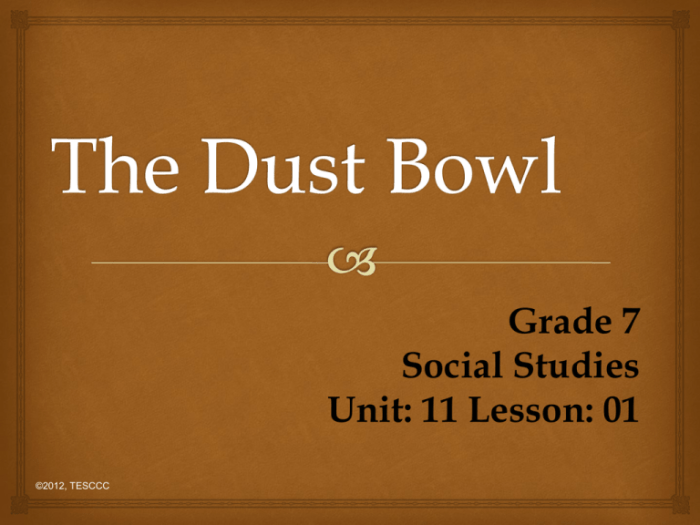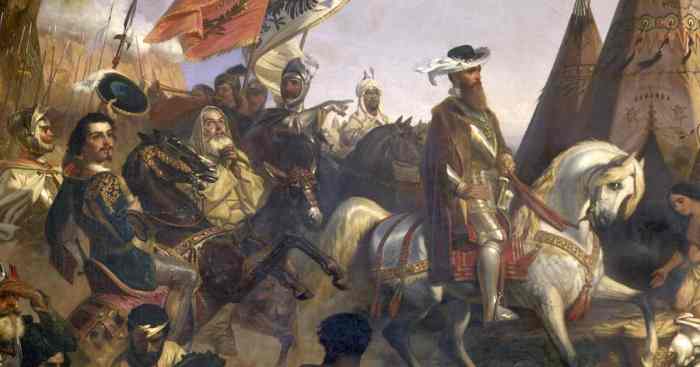Embark on a journey through time with the Dust Bowl Mini Q Answer Key, unlocking the secrets of one of the most catastrophic environmental disasters in American history. From its devastating impact on the Great Plains to the government’s response, this comprehensive guide unravels the complexities of the Dust Bowl.
Delve into the causes, consequences, and cultural legacy of this transformative event, gaining a deeper understanding of its enduring impact on the nation’s landscape and psyche.
The Dust Bowl: Dust Bowl Mini Q Answer Key

The Dust Bowl was a severe drought that affected the US Southern Plains during the 1930s. The drought caused severe damage to the region’s agriculture and economy, and it also led to a mass exodus of people from the region.The
Dust Bowl was caused by a combination of human factors and natural conditions. The human factors included overgrazing of the land, which removed the vegetation that held the soil in place, and the cultivation of marginal land, which was more susceptible to drought.
The natural conditions included a prolonged drought, which began in 1930, and high winds, which picked up the loose soil and carried it away.The Dust Bowl had a devastating impact on the US Southern Plains. The drought caused crops to fail, and the high winds eroded the soil, making it difficult to grow crops.
If you’re struggling with the dust bowl mini q answer key, don’t worry! There are plenty of resources available online that can help you out. One great resource is the website a flat major scale alto sax , which provides detailed instructions on how to play the alto saxophone in the key of A flat major.
With a little practice, you’ll be able to master the dust bowl mini q answer key in no time.
The economic impact of the Dust Bowl was also severe. The drought and erosion caused farmers to lose their livelihoods, and the mass exodus of people from the region led to a decline in the population of the Southern Plains.
The Human Impact of the Dust Bowl

The Dust Bowl, a severe drought that ravaged the Great Plains of the United States in the 1930s, had a profound impact on the lives of those living in the affected areas. The economic, social, and health consequences were devastating, leaving a lasting legacy on the region.
Economic Consequences
The Dust Bowl caused widespread crop failures, leading to severe economic hardship for farmers. The loss of crops and livestock resulted in farm foreclosures and widespread poverty. Many farmers were forced to abandon their land and seek work elsewhere.
Social Effects
The Dust Bowl triggered mass migration as people fled the affected areas in search of better opportunities. This migration led to the rise of migrant labor, with many former farmers forced to take on temporary and often exploitative work.
Health Problems
The Dust Bowl had a significant impact on the health of those living in the affected areas. The constant dust storms caused respiratory illnesses, such as pneumonia and bronchitis. Malnutrition was also common, as food supplies were scarce and diets were poor.
Government Responses to the Dust Bowl

The federal government played a significant role in responding to the Dust Bowl. In 1933, President Franklin D. Roosevelt established the Civilian Conservation Corps (CCC), which employed young men to work on conservation projects in rural areas. The CCC planted trees, built dams, and constructed roads, helping to prevent soil erosion and restore the land.Another
important government program was the Agricultural Adjustment Act (AAA) of 1933. The AAA paid farmers to reduce their crop production, which helped to reduce the amount of land that was exposed to wind erosion. The AAA also encouraged farmers to adopt soil conservation practices, such as terracing and contour plowing.These
government programs had a significant impact on the affected regions. The CCC planted millions of trees, which helped to stabilize the soil and reduce wind erosion. The AAA helped to reduce crop production, which also helped to prevent soil erosion.
These programs also provided much-needed jobs and income to farmers and other rural residents.However, the long-term impacts of government policies on the affected regions were mixed. While the CCC and the AAA helped to mitigate the effects of the Dust Bowl, they also contributed to the decline of small farms.
The CCC and the AAA encouraged farmers to plant fewer crops, which led to a decrease in agricultural production. This, in turn, led to a decrease in farm income and a decline in the number of small farms.Overall, the federal government’s response to the Dust Bowl was a mixed bag.
While the CCC and the AAA helped to mitigate the effects of the disaster, they also contributed to the decline of small farms. The long-term impacts of government policies on the affected regions are still being debated today.
Civilian Conservation Corps (CCC), Dust bowl mini q answer key
The Civilian Conservation Corps (CCC) was a public work relief program that operated from 1933 to 1942 in the United States. The CCC was created by President Franklin D. Roosevelt as part of his New Deal to combat the effects of the Great Depression.
The CCC employed young men between the ages of 18 and 25 to work on conservation projects in rural areas.The CCC planted trees, built dams, and constructed roads, helping to prevent soil erosion and restore the land. The CCC also provided much-needed jobs and income to farmers and other rural residents.The
CCC had a significant impact on the affected regions. The CCC planted millions of trees, which helped to stabilize the soil and reduce wind erosion. The CCC also helped to reduce crop production, which also helped to prevent soil erosion.
These programs also provided much-needed jobs and income to farmers and other rural residents.
Agricultural Adjustment Act (AAA)
The Agricultural Adjustment Act (AAA) was a federal law enacted in 1933 to address the agricultural crisis caused by the Great Depression. The AAA paid farmers to reduce their crop production, which helped to reduce the amount of land that was exposed to wind erosion.
The AAA also encouraged farmers to adopt soil conservation practices, such as terracing and contour plowing.The AAA had a significant impact on the affected regions. The AAA helped to reduce crop production, which also helped to prevent soil erosion. The AAA also provided much-needed income to farmers and other rural residents.However,
the AAA also had some negative consequences. The AAA encouraged farmers to plant fewer crops, which led to a decrease in agricultural production. This, in turn, led to a decrease in farm income and a decline in the number of small farms.Overall,
the federal government’s response to the Dust Bowl was a mixed bag. While the CCC and the AAA helped to mitigate the effects of the disaster, they also contributed to the decline of small farms. The long-term impacts of government policies on the affected regions are still being debated today.
The Dust Bowl in Literature and Culture

The Dust Bowl left an enduring mark on American literature and culture, capturing the struggles and resilience of those who lived through it.
Literary Depictions
Several literary works vividly portray the Dust Bowl experience:
- The Grapes of Wrathby John Steinbeck: A novel that follows the Joad family’s migration from Oklahoma to California during the Dust Bowl, highlighting the hardships and exploitation they faced.
- Invisible Manby Ralph Ellison: A novel that explores the experiences of an unnamed black man living in the South during the 1930s, including the Dust Bowl’s impact on his community.
- Dust Tracks on a Roadby Zora Neale Hurston: An autobiography that recounts Hurston’s experiences as a black woman living in the South during the Dust Bowl, providing a unique perspective on the era.
Film and Television Portrayals
The Dust Bowl has also been portrayed in film and television:
- The Grapes of Wrath(1940): A film adaptation of Steinbeck’s novel, which won two Academy Awards.
- Bound for Glory(1976): A biographical film about folk singer Woody Guthrie, who witnessed the Dust Bowl firsthand and wrote songs about it.
- Ken Burns’ The Dust Bowl(2012): A documentary series that provides a comprehensive overview of the Dust Bowl and its impact.
Cultural Significance
The Dust Bowl remains a significant event in American history, shaping the nation’s understanding of environmental degradation and the importance of conservation:
- Raised Awareness about Environmental Issues:The Dust Bowl brought widespread attention to the consequences of poor land management practices and the need to protect natural resources.
- Prompted Agricultural Reforms:The Dust Bowl led to the establishment of the Soil Conservation Service and other agencies dedicated to promoting sustainable farming practices.
- Inspired Cultural Movements:The Dust Bowl gave rise to the “Dust Bowl Ballads,” folk songs that captured the experiences and struggles of those who lived through it.
FAQ Explained
What geographic regions were affected by the Dust Bowl?
The Dust Bowl primarily affected the southern Great Plains, including parts of Texas, Oklahoma, Kansas, Colorado, and New Mexico.
What were the primary causes of the Dust Bowl?
A combination of severe drought, poor farming practices, and overgrazing contributed to the Dust Bowl.
What was the impact of the Dust Bowl on the economy?
The Dust Bowl caused widespread crop failures and farm foreclosures, leading to severe economic hardship.
How did the government respond to the Dust Bowl?
The federal government implemented various programs, including the Civilian Conservation Corps and the Agricultural Adjustment Act, to mitigate the effects of the Dust Bowl.




